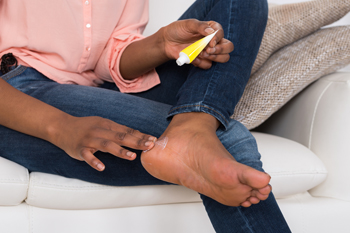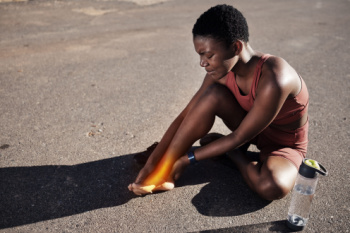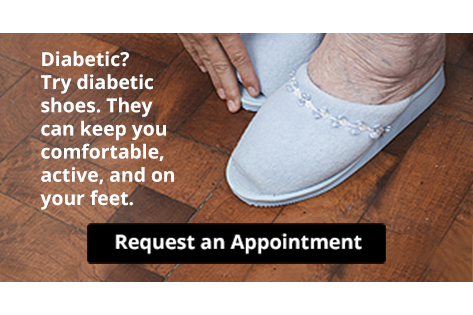Items filtered by date: April 2024
Stress Fractures of the Foot and Lower Leg
 Stress fractures are small cracks in the bones of the foot or lower leg, typically resulting from overuse or repetitive force. Athletes or those engaging in high-impact sports like running, basketball, or dance are more likely to get stress fractures. These injuries can also occur in people who suddenly increase their physical activity without proper conditioning, or those with poor nutrition or weakened bones. One of the main symptoms of a stress fracture is a sharp pain that worsens with activity and improves with rest. The affected area is often sensitive to the touch and may show signs of swelling. The pain is typically localized, making it feel worse during movements that put stress on the specific bone. Preventing stress fractures involves gradually increasing activity levels, wearing appropriate footwear, and incorporating strength training to enhance bone density. If a stress fracture is suspected, a podiatrist can confirm the diagnosis with imaging tests like X-rays or MRI scans. The doctor may recommend rest, possibly immobilization, and a gradual return to activity to ensure proper healing and prevent further injury. If you suspect a stress fracture, it is suggested that you promptly schedule an appointment with a podiatrist.
Stress fractures are small cracks in the bones of the foot or lower leg, typically resulting from overuse or repetitive force. Athletes or those engaging in high-impact sports like running, basketball, or dance are more likely to get stress fractures. These injuries can also occur in people who suddenly increase their physical activity without proper conditioning, or those with poor nutrition or weakened bones. One of the main symptoms of a stress fracture is a sharp pain that worsens with activity and improves with rest. The affected area is often sensitive to the touch and may show signs of swelling. The pain is typically localized, making it feel worse during movements that put stress on the specific bone. Preventing stress fractures involves gradually increasing activity levels, wearing appropriate footwear, and incorporating strength training to enhance bone density. If a stress fracture is suspected, a podiatrist can confirm the diagnosis with imaging tests like X-rays or MRI scans. The doctor may recommend rest, possibly immobilization, and a gradual return to activity to ensure proper healing and prevent further injury. If you suspect a stress fracture, it is suggested that you promptly schedule an appointment with a podiatrist.
Stress fractures occur when there is a tiny crack within a bone. To learn more, contact one of our podiatrists from ABC Podiatry. Our doctors can provide the care you need to keep you pain free and on your feet.
How Are They Caused?
Stress fractures are the result of repetitive force being placed on the bone. Since the lower leg and feet often carry most of the body’s weight, stress fractures are likely to occur in these areas. If you rush into a new exercise, you are more likely to develop a stress fracture since you are starting too much, too soon. Pain resulting from stress fractures may go unnoticed at first, however it may start to worsen over time.
Risk Factors
- Gender – They are more commonly found in women compared to men.
- Foot Problems – People with unusual arches in their feet are more likely to develop stress fractures.
- Certain Sports – Dancers, gymnasts, tennis players, runners, and basketball players are more likely to develop stress fractures.
- Lack of Nutrients – A lack of vitamin D and calcium may weaken the bones and make you more prone to stress fractures
- Weak Bones – Osteoporosis can weaken the bones therefore resulting in stress fractures
Stress fractures do not always heal properly, so it is important that you seek help from a podiatrist if you suspect you may have one. Ignoring your stress fracture may cause it to worsen, and you may develop chronic pain as well as additional fractures.
If you have any questions, please feel free to contact our office located in Columbus, OH . We offer the newest diagnostic and treatment technologies for all your foot care needs.
Causes of Cracked Heels
 Cracked and dry heels can be a bothersome and sometimes painful issue that many people face. There are several common causes behind this condition, including dry skin, lack of moisture, or standing for long periods. Wearing open-back shoes and specific medical conditions, such as diabetes or thyroid disease, can also contribute. People who have atopic dermatitis, psoriasis, and other skin issues may have a higher likelihood of developing cracked heels. When the skin on the heels becomes excessively dry, it loses its elasticity and may crack under pressure, leading to discomfort and potential complications if left untreated. Additionally, certain lifestyle factors, like inadequate hydration or poor foot care practices, can make the problem worse. Podiatrists, or foot doctors, can offer treatments, such as moisturizing creams, exfoliation, or custom orthotics, to provide relief and promote healing. If you are struggling with cracked or dry heels, it is suggested that you consult a podiatrist for help.
Cracked and dry heels can be a bothersome and sometimes painful issue that many people face. There are several common causes behind this condition, including dry skin, lack of moisture, or standing for long periods. Wearing open-back shoes and specific medical conditions, such as diabetes or thyroid disease, can also contribute. People who have atopic dermatitis, psoriasis, and other skin issues may have a higher likelihood of developing cracked heels. When the skin on the heels becomes excessively dry, it loses its elasticity and may crack under pressure, leading to discomfort and potential complications if left untreated. Additionally, certain lifestyle factors, like inadequate hydration or poor foot care practices, can make the problem worse. Podiatrists, or foot doctors, can offer treatments, such as moisturizing creams, exfoliation, or custom orthotics, to provide relief and promote healing. If you are struggling with cracked or dry heels, it is suggested that you consult a podiatrist for help.
Cracked heels are unsightly and can cause further damage to your shoes and feet. If you have any concerns, contact one of our podiatrists from ABC Podiatry. Our doctors can provide the care you need to keep you pain-free and on your feet.
Cracked Heels
Cracked heels appear unappealing and can make it harder for you walk around in sandals. Aside from looking unpleasant, cracked heels can also tear stockings, socks, and wear out your shoes. There are several methods to help restore a cracked heel and prevent further damage.
How Do You Get Them?
Dry skin is the number one culprit in creating cracked heels. Many athletes, walkers, joggers, and even swimmers suffer from cracked heels. Age and skin oil production play a role to getting cracked heels as well.
Promote Healing
Over the counter medicines can help, especially for those that need instant relief or who suffer from chronic dry feet.
Wear Socks – Wearing socks with medicated creams helps lock in moisture.
Moisturizers – Applying both day and night will help alleviate dryness which causes cracking.
Pumice Stones – These exfoliate and remove dead skin, which allows for smoother moisturizer application and better absorption into the skin.
Change in Diet
Eating healthy with a well-balanced diet will give the skin a fresh and radiant look. Your body responds to the kinds of food you ingest. Omega-3 fatty acids and zinc supplements can also revitalize skin tissue.
Most importantly, seek professional help if unsure how to proceed in treating cracked heels. A podiatrist will help you with any questions or information needed.
If you have any questions, please feel free to contact our office located in Columbus, OH . We offer the newest diagnostic and treatment technologies for all your foot care needs.
Who Gets Foot Pain

Foot pain can affect anyone, regardless of age or activity level, and can stem from various causes. Plantar fasciitis, the inflammation of the tissue connecting the heel bone to the toes, often results from overuse or improper foot mechanics, leading to stabbing pain in the heel. Bunions, bony bumps that form at the base of the big toe, can cause discomfort and difficulty walking due to pressure on the joint. Turf toe, an injury to the ligaments surrounding the big toe, commonly affects athletes and results from hyperextension during activities like running or jumping. Treatment for foot pain typically involves rest, stretching exercises, and wearing supportive footwear. In severe cases, custom orthotic devices or surgical intervention may be necessary. Podiatrists specialize in diagnosing and treating foot ailments, offering personalized care plans tailored to each patient's needs. If you want to alleviate existing foot pain, correct foot deformities, or prevent future injuries, it is suggested that you schedule an appointment with a podiatrist to help you restore and maintain foot health.
Foot Pain
Foot pain can be extremely painful and debilitating. If you have a foot pain, consult with one of our podiatrists from ABC Podiatry. Our doctors will assess your condition and provide you with quality foot and ankle treatment.
Causes
Foot pain is a very broad condition that could be caused by one or more ailments. The most common include:
- Bunions
- Hammertoes
- Plantar Fasciitis
- Bone Spurs
- Corns
- Tarsal Tunnel Syndrome
- Ingrown Toenails
- Arthritis (such as Gout, Rheumatoid, and Osteoarthritis)
- Flat Feet
- Injury (from stress fractures, broken toe, foot, ankle, Achilles tendon ruptures, and sprains)
- And more
Diagnosis
To figure out the cause of foot pain, podiatrists utilize several different methods. This can range from simple visual inspections and sensation tests to X-rays and MRI scans. Prior medical history, family medical history, and any recent physical traumatic events will all be taken into consideration for a proper diagnosis.
Treatment
Treatment depends upon the cause of the foot pain. Whether it is resting, staying off the foot, or having surgery; podiatrists have a number of treatment options available for foot pain.
If you have any questions, please feel free to contact our office located in Columbus, OH . We offer the newest diagnostic and treatment technologies for all your foot care needs.
Treat Your Feet to Diabetic Shoes
Types of Hammertoe Treatments
 Treatment for hammertoe, a condition where the toe bends abnormally, varies depending on the severity of the condition. Treatment can range from non-invasive approaches to surgical intervention. Initially, a podiatrist may recommend conservative methods, such as wearing roomier, more comfortable shoes to accommodate the deformity and using custom orthotic devices to relieve pain. Stretching exercises may also be recommended to strengthen toe muscles and improve flexibility. For more persistent cases, where the toe becomes rigid or pain is severe, surgical options may be considered. Surgery aims to straighten the toe, and this may involve removing a portion of the bone or realigning the tendons and ligaments. Post-surgery, patients often go through some rehabilitation to restore function and mobility. Consulting with a podiatrist about hammertoe is suggested to determine the most appropriate treatment plan for your specific needs.
Treatment for hammertoe, a condition where the toe bends abnormally, varies depending on the severity of the condition. Treatment can range from non-invasive approaches to surgical intervention. Initially, a podiatrist may recommend conservative methods, such as wearing roomier, more comfortable shoes to accommodate the deformity and using custom orthotic devices to relieve pain. Stretching exercises may also be recommended to strengthen toe muscles and improve flexibility. For more persistent cases, where the toe becomes rigid or pain is severe, surgical options may be considered. Surgery aims to straighten the toe, and this may involve removing a portion of the bone or realigning the tendons and ligaments. Post-surgery, patients often go through some rehabilitation to restore function and mobility. Consulting with a podiatrist about hammertoe is suggested to determine the most appropriate treatment plan for your specific needs.
Hammertoes can be a painful condition to live with. For more information, contact one of our podiatrists of ABC Podiatry. Our doctors will answer any of your foot- and ankle-related questions.
Hammertoe
Hammertoe is a foot deformity that occurs due to an imbalance in the muscles, tendons, or ligaments that normally hold the toe straight. It can be caused by the type of shoes you wear, your foot structure, trauma, and certain disease processes.
Symptoms
- Painful and/or difficult toe movement
- Swelling
- Joint stiffness
- Calluses/Corns
- Physical deformity
Risk Factors
- Age – The risk of hammertoe increases with age
- Sex – Women are more likely to have hammertoe compared to men
- Toe Length – You are more likely to develop hammertoe if your second toe is longer than your big toe
- Certain Diseases – Arthritis and diabetes may make you more likely to develop hammertoe
Treatment
If you have hammertoe, you should change into a more comfortable shoe that provides enough room for your toes. Exercises such as picking up marbles may strengthen and stretch your toe muscles. Nevertheless, it is important to seek assistance from a podiatrist in order to determine the severity of your hammertoe and see which treatment option will work best for you.
If you have any questions, please feel free to contact our office located in Columbus, OH . We offer the newest diagnostic and treatment technologies for all your foot care needs.
Fit Shoes Properly to Avoid Foot Conditions
 Properly fitting shoes help you maintain foot health and avoid a range of foot conditions, including bunions, calluses, and plantar fasciitis. To ensure that your shoes fit correctly, start by shopping in the late afternoon or evening, as feet tend to swell throughout the day. This will help you find a size that accommodates your feet when they are at their largest. Make sure to have both feet measured, as it is common for one foot to be slightly larger than the other. Choose the size that fits the larger foot comfortably. There should be about a thumb's width of space between the end of your longest toe and the front of the shoe to allow for movement and expansion as you walk. The shoe should fit snugly around the heel and midfoot, without being too tight. This will prevent slippage that could lead to blisters or calluses. Choose shoes with a wide toe box that allows your toes to spread naturally without constriction. Also, consider the shoe's material and arch support, especially if you have specific foot conditions or needs. Podiatrists can provide suggestions for the best shoes for your feet, especially if you are suffering from particular foot conditions. It is suggested that you discuss this topic with a podiatrist to reduce the risk of developing foot problems and enhance your overall foot comfort and health.
Properly fitting shoes help you maintain foot health and avoid a range of foot conditions, including bunions, calluses, and plantar fasciitis. To ensure that your shoes fit correctly, start by shopping in the late afternoon or evening, as feet tend to swell throughout the day. This will help you find a size that accommodates your feet when they are at their largest. Make sure to have both feet measured, as it is common for one foot to be slightly larger than the other. Choose the size that fits the larger foot comfortably. There should be about a thumb's width of space between the end of your longest toe and the front of the shoe to allow for movement and expansion as you walk. The shoe should fit snugly around the heel and midfoot, without being too tight. This will prevent slippage that could lead to blisters or calluses. Choose shoes with a wide toe box that allows your toes to spread naturally without constriction. Also, consider the shoe's material and arch support, especially if you have specific foot conditions or needs. Podiatrists can provide suggestions for the best shoes for your feet, especially if you are suffering from particular foot conditions. It is suggested that you discuss this topic with a podiatrist to reduce the risk of developing foot problems and enhance your overall foot comfort and health.
Finding a properly-fitting shoe is important in reducing injuries and preventing foot problems. For more information about treatment, contact one of our podiatrists from ABC Podiatry. Our doctors will treat your foot and ankle needs.
Proper Shoe Fitting
A common concern when it comes to foot health, having properly fitted shoes can help prevent injuries to the foot. Out feet affect our posture and gait, which in turn affects the biomechanics and overall bodily structure. With 33 joints, 26 bones, and over 100 ligaments, the potential for serious injury is much greater than one realizes. Although the feet cease growth in adulthood, they still change shape as they mature. Here are some factors to consider when it comes to investing in proper fitting shoes:
- Be sure the shoes fit correctly right away
- Ensure the ball of your foot fits comfortably in the widest portion of the shoes
- Even though they may look fashionable, improper fitting shoes can either create adverse conditions or exacerbate existing ones you may already have
- Walk along a carpeted surface to ensure the shoes comfortably fit during normal activity
Keeping in mind how shoes fit the biomechanics of your body, properly-fitting shoes are vitally important. Fortunately, it is not difficult to acquire footwear that fits correctly. Be sure to wear shoes that support the overall structure of your body. Do your feet a favor and invest in several pairs of well-fitted shoes today.
If you have any questions please feel free to contact our office located in Columbus, OH . We offer the newest diagnostic and treatment technologies for all your foot and ankle needs.





